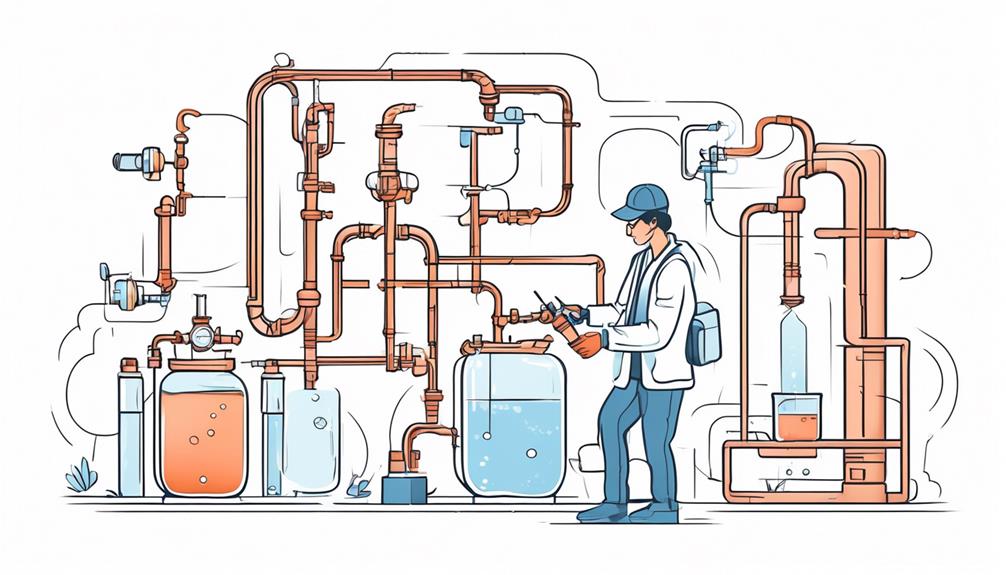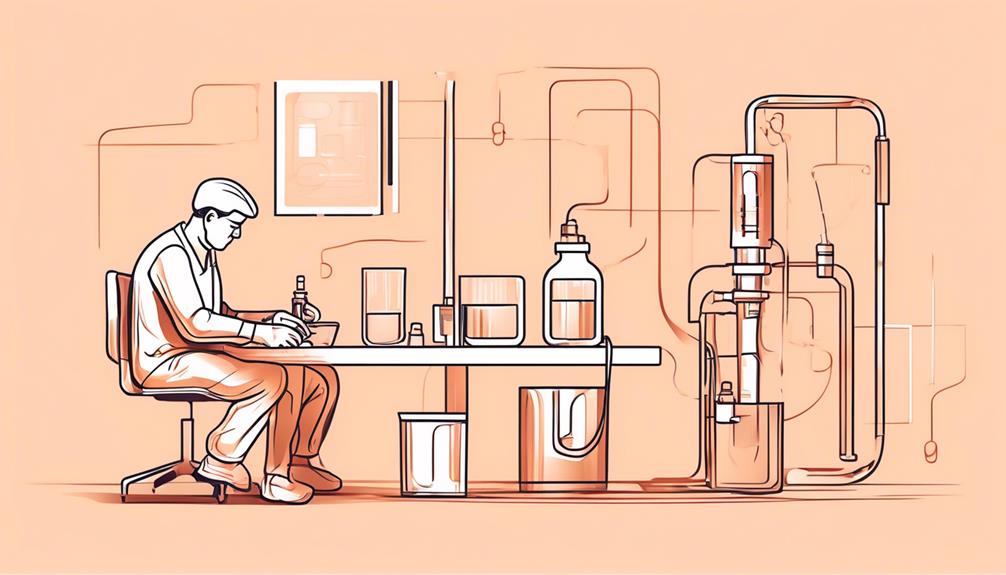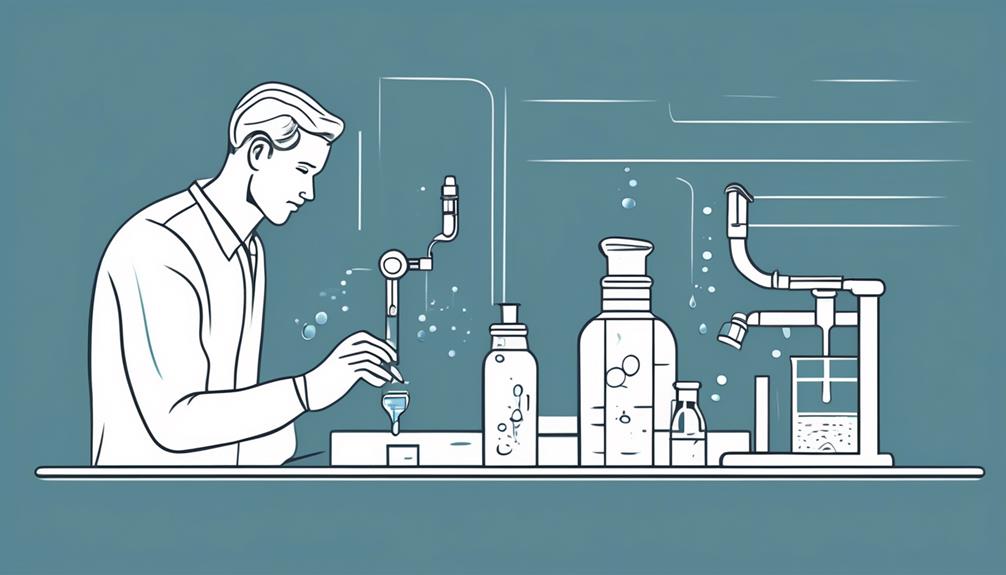If you're looking to keep copper levels in your water within safe limits, there are seven practical tips you should consider.
From preventing water stagnation in copper pipes to actively monitoring and testing for copper content, each step plays a crucial role in safeguarding your water quality.
But that's just the beginning; understanding the sources of copper contamination and employing effective removal methods are key components in this process.
Stay tuned to discover more insights on maintaining safe copper levels in your water and ensuring the well-being of your household.
Key Takeaways
- Regular water testing is crucial to monitor copper levels and ensure safety.
- Using water filtration systems can effectively maintain safe copper levels.
- Prompt action is necessary if copper levels exceed recommended limits.
- Consulting with professionals for expert guidance on copper removal and water quality is important.
Importance of Safe Copper Levels
Ensuring safe copper levels in water is a critical aspect of safeguarding your health and complying with established safety regulations. Monitoring copper levels in your drinking water is vital to prevent adverse health effects. High copper consumption can lead to nausea, vomiting, diarrhea, and headaches. To reduce copper levels, run the tap for 30 seconds, flush toilets, use water filtration systems, and maintain plumbing regularly to minimize copper leaching.
Detecting elevated copper levels is essential. Look out for signs like a metallic or bitter taste, blue-green stains on fixtures, or unusual water taste. Professional water testing is necessary if you suspect high copper levels.
Adhering to safety guidelines, such as setting limits for copper levels and regular water testing, is crucial to maintain safe drinking water quality and protect public health. By staying informed and taking proactive measures, you can ensure that your water sources are free from harmful copper contamination.
Understanding Copper Contamination Sources
Do you know where copper contamination in water can come from?
Common sources can include household copper pipes and the corrosion of plumbing materials.
Understanding these sources is important in keeping your drinking water safe.
Common Copper Sources
When considering common sources of copper contamination in water, it's essential to understand how various factors can contribute to elevated copper levels in your drinking water. Here are some common sources of excess copper in drinking water:
- Copper Pipes and Fixtures:
- Drinking water left standing in copper pipes can lead to higher copper levels.
- Plumbing Systems:
- Copper can enter water through the corrosion of copper plumbing materials.
- Private Wells:
- Water samples from private wells may show high levels of copper.
Remember to conduct regular water testing, consider installing a water filtration system, and follow guidelines set by the Environmental Protection Agency (EPA) to ensure safe copper levels in your drinking water.
Health Effects Overview
To understand the potential health effects of copper contamination sources, it is crucial to recognize how copper can enter water systems and impact drinking water quality. Copper can infiltrate drinking water primarily through the corrosion of copper plumbing materials, resulting in higher levels of copper in the water you consume. Factors like environmental conditions, such as water acidity and temperature, can influence the leaching of copper into drinking water, affecting its quality. Long-term exposure to elevated amounts of copper can have adverse health effects, including liver damage and potentially fatal consequences. Regular testing of your water by accredited laboratories is essential to ensure compliance with safety standards and prompt action if copper levels exceed permissible limits.
—
| Environmental Factors | Potential Health Effects | Testing and Monitoring |
|---|---|---|
| Water Acidity | Liver Damage | Regular Water Tests |
| Temperature | Fatality | Accredited Labs |
| Corrosion | Compliance Standards |
Prevention Methods Recommended
Regular monitoring of copper levels in your drinking water is essential to identify potential sources of contamination and maintain compliance with safety standards. To prevent copper exposure in your home's drinking water, consider the following tips:
- Be Mindful of Water Usage: Monitor water consumption and avoid letting water sit stagnant in the pipes for extended periods.
- Use Water Filters: Install water filtration systems specifically designed to reduce copper levels.
- Regular Plumbing Checks: Inspect household plumbing systems for any signs of corrosion or leaks that could lead to copper contamination.
Regular Testing for Copper Levels
Maintaining safe copper levels in water requires consistent and reliable testing by accredited laboratories to ensure compliance with safety standards. Regular testing for copper is crucial to safeguard your drinking water supplies from potential contamination.
By having your water tested, you can accurately determine the level of copper present and take necessary actions to address any issues promptly. Professional water tests offer more accurate results than DIY tests, providing you with a clearer understanding of any copper exposure risks.
If elevated copper levels are detected, it's essential to take steps such as water treatment or installing a water filtration system to remove copper effectively. By scheduling routine water tests, you can proactively monitor copper levels and ensure the safety of your drinking water.
Effective Copper Removal Methods

Looking to effectively remove copper from your drinking water? Consider options like filtration systems, ion exchange technology, and reverse osmosis systems. These methods can help reduce copper levels and ensure your water remains safe for consumption.
Take proactive steps to maintain safe copper levels in your household water supply.
Filtration for Copper
When aiming to reduce copper levels in your water, consider utilizing effective copper removal methods such as copper water filters. Here are some options to help you maintain safe copper levels in your drinking water:
- Whole-House Filtration Systems: These systems can neutralize acidic water, preventing copper corrosion in plumbing fixtures.
- Under-Sink Reverse Osmosis Systems: Certified to reduce copper from various sources, ensuring your drinking water meets health regulation standards.
- Consulting Experts: Seek guidance from professionals to find suitable filtration solutions tailored to your specific needs, especially if you have elevated copper levels in your water supply. By testing and addressing copper levels, you can safeguard your health and plumbing infrastructure effectively.
Ion Exchange Technology
To effectively combat copper contamination in your water supply, consider exploring the innovative Ion Exchange Technology for efficient copper removal. This method works by exchanging copper ions with other ions, effectively reducing copper levels in drinking water. Ion exchange resins play a crucial role in capturing copper ions and replacing them with harmless ions.
Whether the copper comes from natural sources or elevated levels due to copper corrosion in plumbing, ion exchange technology can effectively treat both scenarios. It's a reliable method used in water treatment systems to meet Environmental Protection standards for tap water quality.
Reverse Osmosis Systems
Reverse Osmosis systems efficiently reduce copper levels in household drinking water, providing a reliable solution for addressing copper contamination. When considering this method, remember these tips for optimal results:
- Use Cold Water: When testing for copper in your drinking water, make sure to use cold water as hot water can cause copper to leach from pipes.
- Allow Water to Run: Before using water from a Reverse Osmosis system, let the water run for a few seconds to ensure any stagnant water is flushed out.
- Consult Experts: To ensure the Reverse Osmosis system effectively removes elevated levels of copper, consult with professionals to find the right system suitable for your needs.
Monitoring Copper Exposure

Monitoring copper exposure is essential for maintaining safe copper levels in water. Your water provider plays a crucial role in ensuring the quality of public drinking water. The Massachusetts Department of Environmental Protection (MassDEP) sets guidelines to limit the amount of copper in your water to prevent adverse health effects. By monitoring copper levels, you can prevent excessive accumulation of this metal in your body, which can be harmful when present above recommended levels. Even though copper is a necessary mineral, being exposed to small trace amounts continuously can lead to an unhealthy buildup over time. Regular monitoring helps to catch any spikes in copper concentration promptly.
The Department of Environmental Protection advises testing your water for copper regularly, especially if you suspect an issue or live in an older home with copper pipes. If you notice any changes in the taste, color, or smell of your water, contact your water provider immediately for guidance on testing and potential solutions to maintain safe copper levels.
Educating on Health Impacts
If you're wondering about the impact copper in your drinking water can have on your health, let's shed some light on the subject. Understanding the health impacts of copper levels in water is crucial for maintaining safety.
Here are some key points to consider:
- Copper levels in drinking water can vary, with sources ranging from natural deposits to household plumbing. It's essential to be aware of how copper enters your water supply.
- Excess copper in water can lead to adverse health effects, such as gastrointestinal issues and liver damage. Monitoring copper levels is vital for your well-being.
- Education on the health impacts of copper in drinking water is necessary to regulate consumption and prevent potential risks. Stay informed to safeguard your health.
Seeking Professional Guidance

For tailored solutions in managing and reducing copper levels in your drinking water, seeking guidance from a water quality expert is essential. When dealing with water containing high amounts of copper, it's crucial to maintain the proper levels to avoid adverse effects on your health.
By consulting with a certified water treatment specialist, you can accurately interpret water test results and determine the most effective treatment methods for copper contamination. These experts can help you select suitable filtration or treatment systems designed specifically to address elevated copper levels in your drinking water.
Whether you rely on a public water supply or a private well, professional assistance can aid in assessing overall water quality, identifying potential sources of copper contamination, and implementing targeted strategies for prevention and remediation. Engaging with a qualified water quality professional ensures access to specialized knowledge and expertise in addressing copper-related concerns, safeguarding the purity of the water you use for drinking or cooking.
Frequently Asked Questions
How Can You Reduce Your Exposure to Copper in Tap Water?
To reduce your exposure to copper in tap water, flush taps for 30 seconds before use, install water filters, monitor water quality, replace copper plumbing, and check groundwater pH levels. Stay proactive for safe water.
How Do You Treat High Copper Levels in Water?
To treat high copper levels in water, consider using a water filter specifically designed to remove copper. These filters can help reduce the amount of copper present in your water, ensuring it stays within safe levels for consumption.
What Is a Safe Level of Copper in Drinking Water?
You can ensure safe copper levels in water by keeping them under the EPA-recommended limit of 1.3 parts per million. Monitoring and testing your water regularly is key to safeguarding your health. Stay informed and stay safe!
Is It Safe to Bathe in Water With High Copper Levels?
Yes, bathing in water with high copper levels can be harmful. Copper exposure through skin contact can lead to skin irritation or other health issues. It's advisable to avoid bathing in water with elevated copper concentrations to stay safe.
Conclusion
Now that you know the importance of maintaining safe copper levels in water, don't forget to take action!
Regular testing, monitoring, and using effective removal methods are key to keeping your water safe to drink.
Remember, a little prevention goes a long way in ensuring that you and your loved ones stay healthy and free from harmful copper exposure.
Stay informed, stay safe!
